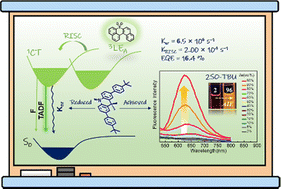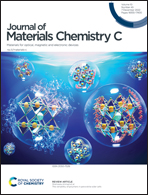Modulating up-conversion and non-radiative deactivation to achieve efficient red thermally activated delayed fluorescence emitters†
Abstract
The development of efficient red electroluminescent devices is one of the formidable challenges in organic light emitting diode (OLED) research. In this work, we reported three efficient red thermally activated delayed fluorescence (TADF) emitters based on the novel dibenzothioxanthene acceptor: 2SO-AD, 2SO-TBU and 2SO-F-TBU. The novel dibenzothioxanthene acceptor with large conjugation allows the energy of the locally excited triplet (3LE) state from the acceptor(A)-segment (3LEA) to be close to the charge transfer (CT) states in red emitters, thus enabling participation of the LE state to facilitate the reverse intersystem crossing (RISC) process. Furthermore, the bulky donor can effectively suppress the aggregation-caused quenching (ACQ), resulting in low non-radiative deactivation of 6.5 × 106 s−1. The red OLED devices based on 2SO-TBU and 2SO-F-TBU emitters achieved the maximum external quantum efficiency (EQEmax) of 16.27% and 14.47%, respectively. This work paves a new way towards efficient red TADF emitters.

- This article is part of the themed collections: 2023 Journal of Materials Chemistry C Lunar New Year collection and 2022 Journal of Materials Chemistry C Most Popular Articles


 Please wait while we load your content...
Please wait while we load your content...